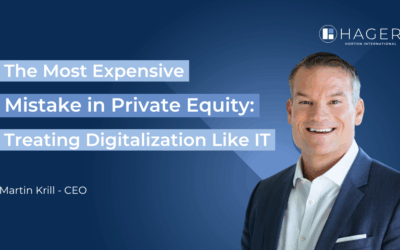Investor Insights | Beyond Capital
Private equity does not lose value because it lacks technology — but because digitalisation is still treated as an IT upgrade rather than a management task. This error in thinking is rarely noticed in the early stages of an investment, but it eats away at silent returns over the entire holding period. The gap between ‘talking about digitalisation’ and ‘leading digitalisation’ is becoming one of the most costly blind spots in the industry.

The biggest blind spot in private equity: technology is seen as a cost factor, not a strategy
Everyone in private equity is talking about digitalisation.
Everyone says it is indispensable.
Everyone is including it in their value creation plans.
But on closer inspection, technology is often reduced to a list of individual projects: an ERP renewal, a new dashboard, a few automation initiatives — perhaps even an AI pilot to keep up with the times.
The uncomfortable truth is that companies rarely fall behind because they lack technology. They fall behind because management still treats digitalisation as an IT project — rather than a fundamental transformation of the way a company operates, makes decisions and competes. As long as digitalisation remains confined to the IT silo, the rest of the company will always move more slowly than the market demands.
At HAGER, digitalisation is not a marginal issue. It is embedded in our understanding of leadership, our organisational assessments and our approach to transformation. Decades of working with investors, founders and technology-driven companies have shown us one thing: digital transformation succeeds or fails because of leadership — not because of tools.
Technology does not create value — leadership does
After more than 30 years of advising investors and portfolio companies, we have seen the entire spectrum of failed digitalisation initiatives: transformation programmes that get stuck before implementation; AI pilots that never make it into everyday use because the data base is unreliable; automation roadmaps that fail not because of technology, but because of culture.
In all these cases, one pattern is clear and unambiguous: technology is almost never the bottleneck. The company behind it is.
Digitalisation fails when decisions are made too slowly, data quality is inconsistent, responsibilities are scattered, or leadership underestimates how much organisational clarity and cultural maturity real transformation requires.
AI accelerates insight.
Automation accelerates execution.
But leadership decides whether the organisation can cope with acceleration at all.
The harsh reality: digital immaturity is a valuation risk
Digital weakness is often portrayed as an operational problem. In reality, it is an assessment problem. A company without integrated systems, shared data architecture, automation expertise, scalable infrastructure or AI readiness is not simply inefficient — it is structurally slow and strategically limited.
In today’s market environment, operational excellence has become alpha. Ignoring digital maturity is not conservative — it is negligent. Investors who treat digitalisation as a side issue are taking on companies that cannot scale at the pace their strategy requires.
Digital due diligence is outdated — and needs to evolve
Traditional digital due diligence usually focuses on the wrong questions:
Which systems are installed?
How modern is the tech stack?
Which tools are outdated?
These questions describe the status quo, but say nothing about a company’s ability to transform itself.
The truly relevant questions are:
- Can the management team make technology-driven decisions?
- Does the culture support transparency and automation?
- Is data treated as a strategic asset — not as a by-product of processes?
- Can the company integrate AI responsibly and effectively?
- And most importantly: Does the organisation have the ability to build and maintain digital progress in the first place?
A tech stack is not a strategy.
A CIO is not a transformation.
A dashboard is not an alignment structure.
As long as digital due diligence remains an IT inventory rather than an assessment of organisational capabilities, investors will buy software — but not scalability.
Transformation begins where power shifts
Organisations do not resist digitalisation because it is complex. They resist it because technology changes power structures.
Digital transparency exposes weak processes.
Automation challenges traditional roles.
Data-based decisions replace political ones.
AI reduces decisions based on hierarchy rather than competence.
That is why the most challenging part of digital transformation is not technical — it is political. Leadership must be prepared to redesign responsibilities, define collaboration and realign incentive systems. Without these changes, even the most advanced technologies remain untapped potential.
The cultural cost of not transforming
Every company pays a hidden tax when it delays digitalisation.
This manifests itself in manual detours, outdated processes, non-transparent reporting, slower decisions, rising costs and cultural fatigue. This tax never appears in the profit and loss statement — but it continuously eats away at the company’s value.
Digitalisation does not mean introducing tools.
It means building an organisation that learns faster than it breaks down — and that requires leadership far more than technology.
What the best investors do differently
The most successful investors know that digital performance begins long before technology. It begins with leadership, structure and culture. They ask who has the ability to drive transformation. They create alignment before introducing new systems. They establish governance that accelerates implementation.
And they build data culture — not just data platforms.
They integrate AI into decisions — not just into isolated workflows.
At HAGER, Digital & Technology is not just a sector. It is our home turf, at the interface between market understanding and leadership expertise. Our experience shows that digital leadership beats digital tools — in every cycle. The strongest platforms are not defined by their software, but by the clarity of their leadership architecture.
Speed comes from systems. Direction comes from leadership.
Digitalisation creates speed. Leadership gives it meaning. And together, they create competitive advantages. Speed may come from systems — but direction always comes from leadership. And it is precisely in this tension that the decisive moment of value creation arises.
As Martin Krill says:
‘Software can be replaced in a matter of months. But the costs of weak leadership cannot be replaced. Most “digital failures” are not technical — they are a lack of courage, clarity and accountability.’
— Martin Krill, CEO, HAGER Executive Consulting
It is precisely at this interface — where systems accelerate and leadership aligns — that digitalisation ceases to be a cost centre and becomes a real value driver.
Conclusion: Technology is not a distinguishing feature. Leadership is.
In a market full of capital and freely available technologies, the real competitive advantage no longer lies in the toolset — but in the organisation that knows how to use it.
Because in private equity, as in leadership, the following applies:
Buying technology is easy.
Implementing it is difficult.
Scaling with it is transformative.
And the companies that understand this will not only outperform the market —
they will define the next one.


